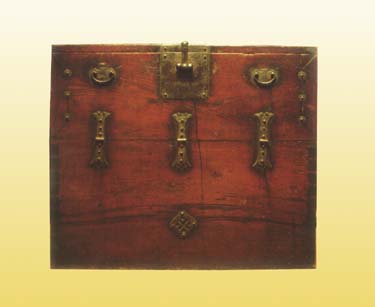| Several unique qualities make this chest special:
Naju bandaji craftsmen had a secret, and they have not let it out to this
day. The hinge on a bandaji is usually the first part to go, because the
heavy solid plank door causes a lot of stress. Hinges made in other regions
relied on a triangular configuration of fasteners at each end to provide
strength, but the more stylish vertical configuration of Naju
hinges provides the same support. Each part of the hinge tapers gradually
from a thick center (where the parts meet) to a thin end; this architecture
is said to provide more strength than a piece of uniform thickness does.
This chest brings long life and good fortune with it. The hinge was done
in a "mushroom of immortality" motif. The plates of the "double-hook" handles
on either side of the hinge use a bat motif; the pronunciation of the Chinese
character for bat in both Chinese and in Korean (bok) is the same
as that of the character that represents good fortune; indeed, the bat
is said to bestow the "five blessings" (longevity, health, wealth, love
of virtue, and a peaceful death). A specialist in this area thinks the
decorative plate at the bottom is an abbreviated version of the Chinese
character su, meaning 'long life'; it may also be a variation of
the symbol of the "seven treasures" (gold, silver, lapis, crystal, coral,
agate, and pearls).
The wood of the body is all from the same red pine log, which must have
been difficult to obtain because of the large size of the panels. Being
from the same log, the wood has the same qualities, which allows all parts
of the chest to breathe in harmony with changes in climate and minimize
the possibility of splitting in dry weather and warping in humid weather.
Dovetail joinery was used in this chest. These yin-yang joints in the bandaji
are traditionally at least as wide as and a little longer than the plank
is thick.
This bandaji also boasts three recessed drawers
inside, to make good use of the upper space that is usually wasted. These
drawers, made from cherry wood, have elegant relief
work (either clouds or "the Buddhist eye" or the mushroom of immortality).
As is in authentic chests, bamboo nails were used to fasten the bottoms
of the drawers. The handles on these doors use a "heavenly
peach" motif.
Naju, a major city in the Chosun dynasty, is one of Korea's most important
sites of classical traditional culture, which explains this chest's restrained,
noble proportions and ornamentation.
|


